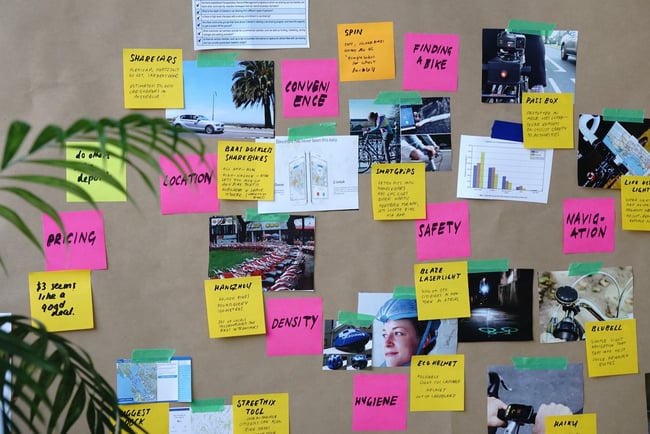Innovation Theater Explained – What Is It and Why Is It So Bad
Now more than ever, large companies have realized that in order to thrive in the long term they need to take their innovation efforts to the next level. However, it’s not always obvious how to do that.
It has become a common practice to resort to innovation activities that seem to have worked for other companies. But not all companies were built the same and such practices don’t necessarily address the real barriers for innovation in yours. That’s how innovation theater starts to creep in without the organization even noticing.
Innovation theater is more common than you might think. To help you understand how to prevent or escape innovation theater, we’ll dive deeper into its root causes and learn how to recognize and overcome it.
So, without further ado, let’s get started.
Table of contents
What is innovation theater
To understand what innovation theater is, you first need to understand innovation. If you’ve followed our writing, you already know that innovation refers to the introduction of anything new. But for innovation to be successful in a corporate context, that’s not enough.
To see long term results with corporate innovation, your innovation should solve specific needs, serve a market, and bring value to customers, and to your company.
What makes corporate innovation so difficult is that it requires a completely different mindset than the one prevalent in most large organizations. These organizations are mostly optimized for efficiency and designed to minimize risks and errors. This creates a lot of barriers for innovation.
Some of the organizations that try to innovate, don’t have the right foundation for it. Usually, the fast and easy solution is to try and adopt what other innovators do. However, what Google is doing with their 20%-time allocation to new projects is not feasible for many companies with less resources.
In an effort to create new solutions, some run activities such as hackathons, innovation workshops or incubators. But such activities don’t always deliver tangible results. This is what usually leads to innovation theater.
So, what is innovation theater?
Innovation theater can be any initiative undertaken with the promise of innovation, but that doesn’t create real business impact.
Innovation theater can be any initiative undertaken with the promise of innovation, but that doesn’t create real business impact.
It’s nice to aspire to be the next Steve Jobs, but how to achieve that? Jobs and Wozniak were true innovators because they put in the hard work, were in the right place at the right time, and stayed focused to a vision and a goal: to simplify complexity and enrich people’s lives.
A lack of focus can easily stir you in the wrong direction and this happens all the time in organizations that believe they can rush innovation with occasional innovation initiatives.

While such activities can help shape and build a better culture, they are not delivering the best results. As Steve Blank points out, for true innovation to happen, you need to redesign the organization and integrate these innovation activities and processes into a cohesive plan.
How to spot innovation theater?
On the surface, everything can look nice and shiny, but if you look more carefully the expected outcomes just won’t be there. No one really sets out to do innovation theater, but many still end up doing it, often without them even realizing it.
To avoid innovation theater, you first need to learn to spot it. Here are some of the most common signs that point to an organization doing innovation theater.
1. Talking the talk without walking the walk
When companies talk too much about how innovative they are, that’s already a red flag. If we look closer, can we see the impact they are having, or the value they are creating? Apple, Tesla, and Amazon keep churning out many more innovations than your average company, but don’t use the term innovation nearly as much. They talk about what they’ve actually created.
Pay attention to your own communication, and if there’s too much hype around innovation without specific outcomes, you might want to tone it down a notch and focus on making progress and getting things done instead.
2. Innovation for the wrong reasons
If innovation campaigns and activities are not part of a business strategy, they are in vain. Without a follow up on the campaign’s results and no person in charge of making things happen, you create innovation theater.
This can happen when you want to show your stakeholder your commitment to innovation. The fast way might be a brainstorming session, an open innovation campaign or some other sort of activity meant to get external or internal input.
In the end, it will be just wasted time and resources for many people. Before deciding on an approach like this, think of the context you’re in and what problems you are trying to solve. Innovation is a tool for driving results, it shouldn’t be a goal in and of itself.
3. The cool office space
We hear quite often about the cool office spaces with colorful bean bags, ping pong tables, and “inspirational” posters. But you should pay attention that there’s not too much focus on the shiny things while nothing really happens in the background.
It’s good to have a team focused on making innovation happen, and sure, they can have their own dedicated space that suits them. However, it’s more important that these teams are not completely disconnected from customers, other teams, or management. Instead, they should be working together to identify and remove practical barriers for innovation. Just like no man is an island, no innovation team should be an island either.
4. Unadjusted processes
The reality is that innovation in a large company is very different from innovation in a start-up, so they naturally need different processes and rules. Yet, some large organizations insist on applying innovation activities familiar from the start-up world in an ad-hoc manner instead of building innovation processes that suit their needs. This could also lead to innovation theatre.
If you want to generate more innovation it’s important to build a solid process that brings together a set of coherent methods. Individually, these methods like design thinking workshops or hackathons might not add too much. But if they are integrated in a process linked to your business strategy, they can become useful.

5. Endless brainstorming sessions
You say innovation, and you first think of creativity and new ideas, right? When companies need more innovation, odds are that they’ll run a brainstorming session.
However, it has been shown that brainstorming doesn’t really generate better, or more ideas than when people don’t interact with others. What’s more, they take valuable time away from focused work that would be required to actually make innovation happen.
That isn’t to say that a well-ran brainstorming couldn’t be useful, but that it’s way too commonly used as a method, and often comes with a big opportunity cost.
There are other, asynchronous ways to collect ideas that are more likely to lead to good ideas, and don’t take up as much time. You could, for example use a dedicated idea management tool to make the job easier and support the process.
Why is innovation theater so harmful?
Innovation Theater could seem harmless at first. After all, something good could come out of all these innovation initiatives, and with innovation you never know where that might be. Well, that can be the case, but at the same time why would you waste precious time and resources on things that you can’t link to future increases in ROI, revenue, profit, or market share?
So, let’s see why innovation theater is so harmful, and what the downsides are.
It distracts you from execution
Innovation theater is more about talking and less about doing – and that’s the big problem. You spend time on what seems to be innovation when in fact you are not addressing real needs or issues.
It’s easy to fall in this trap because innovation theater is focused on the fun activities and distracts you from solving problems that help move the needle in the right direction. You should definitely enjoy the process, but keep in mind that innovation is not supposed to be fun, so you will have to go through more difficult stages too.
You should definitely enjoy the process, but keep in mind that innovation is not supposed to be fun, so you will have to go through more difficult stages too.
Creates short-term innovation hype
Innovation theater can easily create excitement in a company but since those efforts are not sustained, people will soon be disillusioned. When people become skeptical about innovation, you’re in a really difficult situation. At that point, it will be extremely hard to convince people of your good intentions with innovation.
Generates little or no real value
You choose to innovate because you want to bring more value in a form or another. We know this doesn’t come easy, but if you fall in the trap of innovation theater it’s highly unlikely that you will achieve that.
When innovation theater occurs, you don’t have a person in charge with the follow up, implementation, strategic continuation of the project and so on. In the end, the outcome is not prioritized, the activities are.

How to avoid innovation theater
The problems that lead to innovation theater can be very complex and we shouldn’t underestimate the impact they have at an organizational level. Keeping your eyes on the prize will help you overcome those obstacles.
Often times, the first innovation initiatives to undertake should be organizational innovations, so you can have a solid foundation for future innovation efforts.
Often times, the first innovation initiatives to undertake should be organizational innovations, so you can have a solid foundation for future innovation efforts.
There are also other things you can do to avoid falling in the trap of innovation theater:
1. Align innovation with your strategic goals
This is one of the first things you should consider. Before spending time and resources on incubators, accelerators or other innovation activities you should first look at your overall strategic goals and understand how innovation fits in there.
After all, innovation is just one tool that can support the overall goals of the organization. It’s great if you want to innovate throughout the entire organization, but to be successful this should be done methodically, with a focus on the strategic goals.
2. Don’t copy innovation stereotypes blindly
Innovation looks different for each organization. Unfortunately, some tend to fall in the trap of following stereotypes without context. They believe they should use a specific playbook to become the next Airbnb or the next Uber.
But every company has, or at least should have their own story and path, and it’s not feasible to replicate those of someone else. It is a good idea to look around and learn from others, but don’t just copy their practices blindly. Try to understand why they’re doing what they’re doing and use those insights to design processes that work for you.
3. Don’t fall in love with technology
There’s a common misconception that innovation equals technology. There are many types of innovation and not all of them have to do with the latest tech.
When you get stuck on certain technologies that seem to be the next big breakthrough, you could be paving your way towards innovation theater. While sustained R&D efforts on emerging technologies can work for some, it’s important to focus on providing value and to make sure your potential innovation has real utility, and a market. It shouldn’t be just a new idea wrapped in cool technology.
For example, Ernit’s founder, Soren Nielsen can look back and see how his love for IoT (Internet Of Things) which was the buzz word at that time, lead him to innovation theater and ultimately, failure. The piggy bank connected to an app seemed to be the thing that all children would need for a better financial education. While innovation theater was not the sole contributor to its failure, we can see how it has influenced the result.
The best approach is to first validate the problem and then see if your solution solves it. Coming up with a solution before identifying a real problem can easily send you in the wrong direction.
4. Focus on the outcomes, not the activities
Innovation events, such as hackathons, are often innovation theater if no one focuses on what happens after the event to pursue the desired outcomes.
If you want to see some real results, you should carefully pick KPIs that measure your innovation performance and related outcomes. A very common mistake is to just use input metrics, such as number of ideas, hackathons organized, number of participants, and so on.
What do those input metrics tell you about the value you’ve really delivered? At the end of the day, it’s the tangible outcomes that matter.
So instead of wasting your energy on organizing fun events, put the effort towards new organizational design, and processes that can enable innovation. Spend more time on securing the budget you need, getting the right talent on board, and implementing the best ideas.
No matter the activity, someone has to be in charge of actually making those ideas a reality. Which takes us to our next point.
5. Remove barriers & empower teams to innovate
A big barrier innovators face are the existing processes, approvals, and other bureaucracy and complexities of large organizations. Ideas and projects that take a few weeks to implement in a startup can easily take a year in a big company.
Even though many processes are necessary for companies to function well, they sometimes strip innovators of their ability to make decisions or progress. And when you can’t get things approved or make hard decisions, real transformation is very difficult.
Top management plays an important role here as their commitment to innovation transpires throughout the entire company. Instead of everything having to go through them, they should empower their workforce to innovate and make important decisions throughout the organization in pursuit of those.
Conclusion
Innovation theater is a highly discussed topic for a reason. It’s easy to fall in the trap and mix up innovation activities with the outcomes.
Let’s remember that what top innovators seem to do on the surface is not what made them successful. In the background there is a lot of hard work, trial and error and more hard work.
Do you want to go beyond innovation theater and drive some real results with innovation? Let us show you how with a Viima demo!







.jpg)
